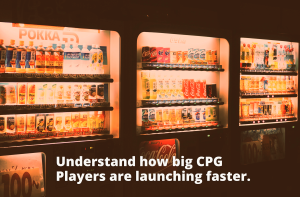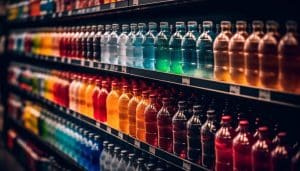The environmental impact of mass consumer products has been extensively documented for quite some time. The speed of communication has contributed to making sustainability a topic that has never been as important to consumers as it is today. The impact of human consumption on the planet has become a current concern of the population, and connecting with this expectation has become a crucial issue for brands.
Studies suggest that fast-moving consumer products account for 60% of greenhouse gas emissions and between 50 to 80% of global land, material, and water usage. This makes the Consumer Packaged Goods industry a highly significant player in the construction of a more sustainable economy.
The Sustainability Imperative
Packaging is strongly tied to the CPG industry and it’s one of the largest contributors to plastic waste generation and environmental degradation. As consumers become more eco-conscious to make their choices, CPG companies are fully aware about the importance of sustainable practices in packaging development. Sustainability is not just a trend anymore, it’s strategic and exploring innovative solutions across packaging became imperative.
Consumer Perceptions and Market Impact
Sustainable packaging isn’t just about meeting regulatory requirements or reducing environmental impact, it’s tied to satisfying consumer preferences. Today’s consumers are more environmentally conscious than ever, and their purchasing decisions are increasingly influenced by a company’s sustainability efforts.
A Nielsen survey found that 81% of global respondents felt strongly that companies should help improve the environment. This sentiment is particularly strong among millennials and Generation Z consumers. Brands that prioritize sustainability in packaging often see improved customer loyalty and a competitive edge in the market.
Also, eco-friendly packaging isn’t just a moral obligation, it also makes economic sense. Sustainable packaging innovations can lead to cost savings through reduced material usage, streamlined logistics, and improved brand reputation. It’s good for everyone!
The Regulatory Landscape
Government regulations play a key role in shaping sustainable packaging practices within the CPG sector. Countries and regions around the world are introducing legislation aimed at curbing plastic pollution and promoting environmentally friendly packaging. These regulations not only push CPG companies to adopt sustainable packaging practices but also drive innovation as they seek compliance solutions.
The regulatory landscape for packaging waste management varies significantly around the globe. In many developed nations, there is a growing focus on sustainability and reducing the environmental impact of packaging materials. As a result, stringent regulations have been introduced to tackle packaging waste:
- In the European Union, the Packaging and Packaging Waste Directive sets targets for recycling and recovery rates of packaging materials, encouraging producers to minimize packaging and increase recycling efforts. The EU’s Single-Use Plastics Directive also aims to reduce the consumption of single-use plastics and promote the use of alternative materials.
- In the United States, the regulatory approach to packaging waste is more fragmented, with individual states adopting their own policies and regulations. Some states have implemented Extended Producer Responsibility (EPR) programs, shifting the responsibility for recycling and waste management onto producers and brand owners. Additionally, the U.S. Environmental Protection Agency (EPA) has established guidelines and initiatives to encourage recycling and sustainable packaging practices, although a comprehensive federal regulatory framework is still evolving.
- In emerging economies, where waste management infrastructure may be less developed, the regulatory landscape for packaging waste is evolving as environmental concerns grow. Some countries are beginning to introduce regulations and incentives to address packaging waste issues, often drawing inspiration from more established regulatory models. Overall, the global regulatory landscape for packaging waste reflects the recognition of the need for sustainable packaging practices and the importance of reducing the environmental impact of packaging materials.
Environmental regulations and consumer expectations are helping to drive packaging innovation. The CPG industry is recognizing that staying competitive and meeting consumer demands needs a proactive approach balancing regulatory requirements and the values of eco-conscious consumers.
Among several innovations some stand out:
- Reducing Single-Use Plastics: One of the most prominent trends in sustainable packaging is the phasing out of single-use plastics. Companies are opting for alternative materials such as biodegradable plastics, compostable packaging, and paper-based alternatives to minimize plastic waste.
- Recyclable and Recycled Materials: Recycling is a key component of the circular economy. Many CPG companies are redesigning packaging using materials that are easily recyclable, and some are even incorporating recycled content into their packaging, reducing the need for virgin materials.
- Minimalistic Design: Minimalistic packaging design, with fewer layers and materials, not only reduces waste but also lowers production costs. This trend aligns with the concept of “less is more” and resonates with eco-conscious consumers.
- Smart Packaging: Advancements in technology have led to the development of smart packaging solutions that offer enhanced traceability, food safety, and freshness indicators. These innovations reduce food waste and help consumers make informed choices.
- Eco-Friendly Inks and Labels: Sustainable packaging isn’t just about materials; it also encompasses the inks and labels used. Vegetable-based inks and labels that easily detach during recycling are becoming popular choices.
- Reusable Packaging: Reusable packaging models, such as refill stations and subscription-based systems, are gaining traction. These initiatives reduce packaging waste and encourage consumers to adopt eco-friendly habits.
All about plastic
Plastic is one of the first thoughts when talking about packaging. It’s cheap to produce, and it’s efficient to preserve produtcs. Plastics use has soared in recent decades, reaching an amazing estimated of 460 million metric tons in recent years. Packaging accounted for approximately 31% of this, making it the largest plastics consuming segment. Good for the industry, bad for the planet. According to the UN Environment Programme, every day, 2000 garbage trucks full of plastic are dumped into the oceans, rivers, and lakes.
Good news are many CPG prominent companies have embraced sustainable packaging innovation:
- Kellogg’s
The company have one of the smallest plastic footprints in the industry, but they are currently using recycled cardboard, and overall 76% of packaging is recyclable. By the end of 2025 the company aims to make 100% of packing either recyclable or compostable. - Natura
The cosmetics giant (owner of Avon and The Body Shop) is a pioneer in the Brazilian market by launching packaging refills in 1983. Now a global company, Natura is in constant research for developing sustainable packaging and aims to increase the percentage of packaging made from biodegrable plastic produced from sugar cane. - Unilever
The global consumer goods giant is committed to making all its plastic packaging recyclable, reusable, or compostable by 2025. They are actively reducing single-use plastics and investing in research to develop sustainable packaging alternatives. - Coca-Cola
The beverage company has pledged to make 100% of its packaging recyclable by 2025. They are also investing in plant-based plastics and exploring the use of recycled materials in their PET bottles. - Nestlé
One of the largest food companies is transitioning to recyclable or reusable packaging for its products and has also set a goal to achieve zero net emissions by 2050. - Procter & Gamble
P&G aims to make 100% of its packaging recyclable or reusable by 2030. They have introduced innovations like the “Fairy Ocean Plastic” bottle, made from 100% recycled and ocean-bound plastic. - Patagonia
While primarily in the apparel industry, Patagonia’s “Worn Wear” initiative encourages consumers to buy used clothing. This sustainability-focused approach extends to their packaging, with mailers made from 100% recycled materials.
The burning question: Is switching from traditional packaging to more sustainable packaging worth the investment?
The answer is a simple yes! Packaging waste is a serious global issue and it’s clear that reducing every industry’s carbon footprint is imperious. The switch to sustainable packaging isn’t only for eco-conscious brands aiming to reduce their environmental impact. It is also a good business strategy.
- Show your business commitment to environmental responsibility fosters customer loyalty. Over the past five years, global online searches for sustainable products have surged by 71%. Customers are increasingly mindful of the ecological consequences of their choices. They now seek to engage with brands that share their values. Therefore, by emphasizing and publicizing your sustainability initiatives, you significantly enhance your prospects of retaining existing customers while also attracting new ones.
- Prioritizing more sustainable packaging also aligns with regulatory compliance. It’s crucial to consider the consequences of not transitioning to eco-friendly materials. Authorities are tightening regulations on packaging materials that fail to meet minimal environmental criteria. Measures like the Extended Producer Responsibility policy, such as the UK’s Plastic Packaging Tax, are becoming increasingly prevalent. Non-compliant businesses may face substantial fines as a result.
3. Investments in sustainable practices will lead to cost reductions as demand surges. It’s true that some of the innovative sustainable packaging materials may not be as straightforward to manufacture as traditional options like plastic. This should not dissuade you from investing in them.
Innovation Driver
Fostering innovation in CPG is one of GrowinCo.’s pillars. On our proprietary digital platform for b2b collaboration and co-manufacturing, companies can find packaging suppliers for their sustainability project demands.
Companies post a project specifying their needs on the platform, that identifies capabilities from different suppliers. Suppliers are then selected and invited for the project. The results are projects like the following two examples:
- Packaging Redesign for a global snack brand
In a bid to follow their packaging strategy a global snack brand needed to identify a new sustainable packaging structure. Their goal was to not only minimize environmental footprint but also to be perceived as a conscious brand.
The results of this challenge were nothing short of impressive. The brand garnered the attention of 13 potential partners who were willing to enter into Non-Disclosure Agreements. That reflected the excitement and interest generated by their sustainability initiative. Furthermore, they received seven concrete proposals from key suppliers. All of them vying to contribute their expertise to the Brand’s vision of a more sustainable packaging solution. - Global Packaging Innovation & Productivity to a global leader in the snacks industry
Another remarkable case study within GrowinCo. in sustainable packaging innovation comes from a global leader in the snacks industry. They initiated the Global Packaging Innovation & Productivity project. Their ambition was fostering consumer-centric growth by leveraging packaging as a competitive advantage while adhering to sustainability principles.
The results of this initiative speak volumes about its impact. The project attracted more than 50 solution providers and collaborators, all eager to contribute their insights and capabilities. Additionally, 30 signed NDAs indicated the high level of interest and confidentiality surrounding the project. That highlights the valuable nature of the work being undertaken. The collaboration extended to four webinars with suppliers, further fostering an environment of knowledge sharing and innovation. In the end, the project received over 30 proposals, showcasing the depth and breadth of creativity within the industry.
These are real examples about how the power of sustainability in reshaping brands image and attracting strategic partnerships. By stating a commitment to sustainability, we helped those companies not only strengthened its position in the market but also tapped into a network of suppliers eager to support their mission. Also, it is clear how industry leaders can take proactive steps to drive sustainability while staying competitive. By engaging a wide network of stakeholders and fostering collaboration, they not only innovate but also inspire others to join the journey toward more sustainable packaging solutions.
The CPG industry’s commitment to sustainable packaging innovations is a testament to its dedication to environmental responsibility and consumer satisfaction. As consumers increasingly demand eco-friendly options, CPG companies have realized that sustainability isn’t just a moral obligation; it’s a business imperative. By embracing trends such as reducing single-use plastics, using recyclable materials, and adopting minimalistic designs, CPG companies are not only reducing their environmental footprint but also meeting the evolving expectations of their customer base. As sustainability continues to shape consumer choices, the CPG sector’s focus on eco-friendly packaging solutions will remain a key driver of growth and competitiveness in the industry.





